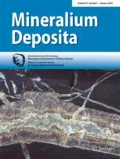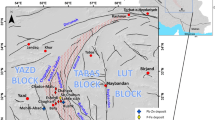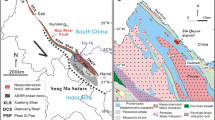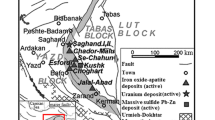Abstract
Iron oxide–apatite (IOA) deposits, often referred to as Kiruna-type iron ore deposits, are known to have formed from the Proterozoic to the Tertiary. They are commonly associated with calc–alkaline volcanic rocks and regional- to deposit-scale metasomatic alteration. In the Bafq District in east Central Iran, economic iron oxide–apatite deposits occur within felsic volcanic tuffs and volcanosedimentary sequences of Early Cambrian age. In order to constrain the age of formation of these ores and their relationship with the Early Cambrian magmatic event, we have determined the U–Pb apatite age for five occurrences in the Bafq District. In a 206Pb/238U vs. 207Pb/235U diagram, apatite free of or poor in inclusions of other minerals plots along the Concordia between 539 and 527 Ma with four out of five samples from one deposit clustering at the upper end of this range. For this deposit, we interpret this cluster to represent the age of apatite formation, whereas the spread towards younger ages may reflect either minor Pb loss or several events of IOA formation. Apatite with inclusions of monazite (±xenotime) yields disturbed systems with inclusions having developed after formation of the iron ore–apatite deposits, possibly as late as 130–140 Ma ago. Obtained apatite ages confirms that (IOA) and the apatite-rich rocks (apatites) of the Bafq district formed coevally with the Early Cambrian magmatic (-metasomatic) events.






Similar content being viewed by others
References
Cliff RA, Rickard D (1992) Isotope systematics of the Kiruna magnetite ores, Sweden; Part 2, Evidence for a secondary event 400 m.y. after ore formation. Econ Geol 87:1121–1129
Cliff RA, Rickard D, Blake K (1990) Isotope systematics of the Kiruna magnetite ores, Sweden; Part 1, Age of the ore. Econ Geol 85:1770–1776
Corriveau L, Mumin H (Eds) (2010) Exploring for iron oxide copper–gold deposits: Canada and global analogues. Geol Assoc Canada, Short Course Notes 20, p 192
Corriveau L, Williams P, Mumin H (2010) Alteration vectors to IOCG mineralization from uncharted terranes to deposits. In: Corriveau L, Mumin H (eds) Exploring for iron oxide copper–gold deposits: Canada and Global analogues. Geol Assoc Canada, Short Course Notes 20, pp 87–106
Daliran F (1990) The magnetite–apatite deposit of Mishdovan, East-Central Iran. An alkali rhyolite hosted, “Kiruna-type” occurrence in the Infracambrian Bafg metallotect. Heidelb Geowiss Abh 37:248
Daliran F (2002) Kiruna-type iron oxide–apatite ores and “apatitites” of the Bafq District, Iran, with an emphasis on the REE geochemistry of their apatites. In Porter TM (Ed) Hydrothermal Iron Oxide Copper–Gold and related deposits, vol 2. PGC Publishing Australia, pp 303–320
Daliran F, Stosch H-G, Williams P (2007) Multistage metasomatism and mineralization at hydrothermal Fe oxide-REE-apatite deposits and “apatitites” of the Bafq District, Central-East Iran. In: Andrew CJ et al. (eds) Digging Deeper. Proceedings of the 9th Biennial SGA Meeting Dublin 2007. Irish Assoc Econ Geol, pp 1501–1504
Daliran F, Stosch H-G, Williams P (2009) A review of the Early Cambrian Magmatic and Metasomatic events and their bearing on the genesis of the Fe oxide-REE-apatite deposits (IOA) of the Bafq District, Iran. In: Williams et al. (eds) Smart science for exploration and mining: proceedings of the 10th Biennial SGA Meeting, Townsville, Australia, 17th–20th August 2009
Daliran F, Stosch H-G, Williams P, Jamli H, Dorri MB (2010) Early Cambrian Iron Oxide-Apatite-REE (U) Deposits of the Bafq District, East-Central Iran. In: Corriveau L, Mumin H (eds) Exploring for Iron oxide copper–gold deposits: Canada and Global analogues. Geol Assoc Canada, Short Course Notes 20, 143–155
Förster H, Jafarzadeh A (1994) The Bafg mining district in Central Iran: a highly mineralized Infracambrian volcanic field. Econ Geol 89:1697–1721
Frietsch R (1978) On the magmatic origin of iron ores of the Kiruna type. Econ Geol 73:478–485
Frietsch R, Perdahl J-A (1995) Rare earth elements in apatite and magnetite in Kiruna-type iron ores and some other iron ore types. Ore Geol Rev 9:489–510
Frietsch R, Tuisku P, Martinsson O, Perdahl J-A (1997) Early Proterozoic Cu-(Au) and Fe ore deposits associated with regional Na-Cl metasomatism in northern Fennoscandia. Ore Geol Rev 12:1–34
Geijer P (1931) The iron ores of the Kiruna type: Sveriges GeologiskaUndersökning, C367, p 39
Gerstenberger H, Haase G (1997) A highly effective emitter substance for mass spectrometric Pb isotope ratio determinations. Chem Geol 136:309–312
Groves DI, Bierlein FP, Meinert LD, Hitzman MW (2010) Iron oxide copper–gold (IOCG) deposits through Earth history: implications for origin, lithospheric setting, and distinction from other epigenetic iron oxide deposits. Econ Geol 105:641–654
Haghipour A (1975) Etude géologique de la région de Biabanak-Bafg (Iran Central): Pétrographie et tectonique du socle Précambrien et de sa couverture. Unpublished thesis (Doctorat d’Etat), Grenoble University: p 403
Harlov D, Förster H-J (2003) Fluid-induced nucleation of (Y + REE)-phosphate minerals within apatite: Nature and experiment. Part II. Fluorapatite. Am Mineral 88:1209–1229
Harlov DE, Andersson UB, Nyström JO, Förster H-J, Broman C, Dulski P (2002) Apatite-monazite relations in the Kiirunavaara magnetite–apatite iron ore, northern Sweden. Chem Geol 191:47–72
Harlov DE, Wirth R, Förster H-J (2005) An experimental study of dissolution–reprecipitation in fluorapatite: fluid infiltration and the formation of monazite. Contrib Mineral Petrol 150:268–286
Henríquez F, Naslund HR, Nyström JO, Vivallo W, Aguirre R, Dobbs FM, Lledó H (2003) New Field evidence bearing on the origin of the El Laco magnetite deposit, northern Chile—A discussion. Econ Geol 98:1497–1500
Hitzman MW (2000) Iron oxide-Cu-Au deposits: what, where, when, and why. In: Porter TM (ed) Hydrothermal iron oxide-copper-gold and related deposits: a global perspective, vol 1. PGS Publishing, Australia, pp 9–25
Holliger P, Pagel M, Pironen J (1989) A model for 238U radioactive daughter loss from sediment-hosted pitchblende deposits and the Late Permian–Early Triassic depositional U–Pb age of the Müllenbach uranium ore (Baden–Württemberg FRG). Chem Geol 80:45–53
Jami M (2005) Geology, geochemistry and evolution of the Esfordi phosphate-iron deposit, Bafq area, Central Iran. Unpublished Dissertation, University of New South Wales
Ludwig KR (1978) Uranium-daughter migration and U/Pb isotope apparent ages of uranium ores Shirley Basin. Econ Geol 73:29–49
McDonough WF, Sun S-S (1995) Composition of the Earth. Chem Geol 120:223–253
Mumin AH, Somarin AK, Jones B, Corriveau L, Ootes L, Camier J (2010) The IOCG–porphyry–epithermal continuum in the Great Bear Magmatic Zone, Northwest Territories, Canada. In: Corriveau L, Mumin H (eds) Exploring for iron oxide copper–gold deposits: Canada and global analogues. Geol Assoc Canada, Short Course Notes 20, pp 57–75
NISCO–National Iranian Steel Company (1980) Report on results of search and evaluation works at magnetic anomalies of the Bafq iron ore region during 1976–1979. Unpubl Rpt, p 260
Pan Y, Fleet ME (2002) Compositions of the apatite-group minerals: Substitution mechanism and controlling factors. In: Kohn MJ, Rakovan J, Hughes JM (eds) Phosphates—geochemical, geobiological, and materials importance. Mineralogical Society of America; Geochemical Society, Washington, pp 13–49
Pfaff K, Romer RL, Markl G (2009) U-Pb ages of ferberite, chalcedony, agate, U-mica and pitchblende: constraints on the mineralization history of the Schwarzwald ore district. Eur J Mineral 21:817–836
Piccoli PM, Candela PA (2002) Apatite in igneous systems. In: Kohn MJ, Rakovan J, Hughes JM (eds) Phosphates (reviews in mineralogy and geochemistry 48). Miner Soc America and Geochemical Society, Washington, pp 255–292
Porter TM (2001) (ed) Hydrothermal iron oxide copper–gold and related deposits. PGC Publishing Australia, p 349
Porter TM (2002) (ed) Hydrothermal Iron oxide copper–gold and related deposits. PGC Publishing Australia, p 377
Pouchou JL, Pichoir F (1988) A simplified version of the ‘PAP’ model for matrix corrections in EPMA. In: Newbury DE (ed) Microbeam analysis. San Francisco Press, San Francisco, pp 315–318
Ramezani J, Tucker RD (2003) The Saghand region, Central Iran: U–Pb geochronology, petrogenesis and implications for Gondwana tectonics. Am J Sci 303:622–665
Rhodes AL, Oreskes N, Sheets S (1999) Geology and rare earth element geochemistry of magnetite deposits at El Laco, Chile. In: Skinner BJ (ed) Geology and ore deposits of the Central Andes. Soc Econ Geol, Spec Pub 7, pp 299–332
Romer RL (1996) U-Pb systematics of stilbite-bearing low-temperature mineral assemblages from the Malmberget iron ore, northern Sweden. Geochim Cosmochim Acta 60:1951–1961
Romer RL (2003) Alpha-recoil in U-Pb geochronology: effective sample size matters. Contrib Mineral Petrol 145:481–491
Romer RL, Martinsson O, Perdahl JA (1994) Geochronology of the Kiruna iron ores and hydrothermal alterations. Econ Geol 89:1249–1261
Romer RL, Förster H-J, Breitkreuz C (2001) Intracontinental extensional magmatism with a subduction fingerprint: the late Carboniferous Halle Volcanic Complex (Germany). Contrib Mineral Petrol 141:201–221
Romer RL, Heinrich W, Schröder-Smeibidl B, Meixner A, Fischer C-O, Schulz C (2005) Elemental dispersion and stable isotope fractionation during reactive fluid-flow and fluid immiscibility in the Bufa del Diente aureole, NE-Mexico: evidence from radiographies and Li, B, Sr, Nd, and Pb isotope systematics. Contrib Mineral Petrol 149:400–429
Romer RL, Thomas R, Stein H, Rhede D (2007) Dating multiply overprinted Sn-mineralized granites—examples from the Erzgebirge, Germany. Miner Deposita 42:337–359
Samani B (1998) Precambrian metallogeny in Central Iran. AEOI Sciences Bulletin 17:1–16 (in Farsi with English abstract)
Schärer U (1984) The effect of initial 230Th disequilibrium on young U-Pb ages: the Makalu case, Himalaya. Earth Planet Sci Lett 67:191–204
Schmid R, Romer RL, Franz L, Oberhänsli R, Martinotti G (2003) Basement–cover sequences within the UHP unit of the Dabie Shan. J Metamorph Geol 21:531–538
Skirrow RG (2010) ‘Hematite-group’ IOCG ± U ore systems: tectonic setting, hydrothermal characteristics, and Cu-Au and U mineralizing processes. In: Corriveau L, Mumin H (eds) Exploring for iron oxide copper–gold deposits: Canada and Global Analogues. Geol Assoc Canada, Short Course Notes 20, pp 37–56
Skirrow RG, Sillitoe R, Burrows D (2002) New field evidence bearing on the origin of the El Laco magnetite deposit, northern Chile. Econ Geol 97:1101–1109
Steiger RH, Jäger E (1977) Subcommission on geochronology: convention on the use of decay constants in geo- and cosmochronology. Earth Planet Sci Lett 36:359–362
Torab FM (2008) Geochemistry and metallogeny of magnetite–apatite deposits of the Bafp mining district, central Iran. PhD thesis, TU Clausthal, p 131
Torab FM, Lehmann B (2007) Magnetite–apatite deposits of the Bafq district, Central Iran: apatite geochemistry and monazite geochronology. Mineral Mag 71:347–363
Verdel C, Wernicke BP, Ramezani J, Hassanzadeh J, Renne PR, Spell TL (2007) Geology and thermochronology of Tertiary Cordilleran-style metamorphic core complexes in the Saghand region of Central Iran. Geol Soc Amer Bull 119:961–977
Williams P (2010a) Classifying IOCG deposits. In: Exploring for iron oxide copper–gold deposits: Canada and global analogues. Geol Assoc Canada, Short Course Notes 20, pp 11–19
Williams P (2010b) “Magnetite-Group” IOCGs with special references to Cloncurry and Northern Sweden: settings, alteration, deposit characteristics, fluid sources, and their relationship to apatite-rich iron ores. In: Exploring for iron oxide copper–gold deposits: Canada and global analogues. Geol Assoc Canada, Short Course Notes 20, pp 21–36
Williams PJ, Pollard PJ (2001) Australian Proterozoic iron oxide-Cu-Au deposits: an overview with new metallogenic and exploration data from the Cloncurry District, Northwest Queensland. Explor Min Geol 10:191–213
Acknowledgments
This work was supported by a grant from the DFG (German Science Foundation) to HGS. Field work was carried out in cooperation with the Geological Survey of Iran. We would like to particularly thank J. Ramezani (MIT) who shared his valuable knowledge on the geology of the Bafq region with us. We are indebted to E. Pelleter for a constructive review that helped us to improve the manuscript significantly and to B. Lehmann for his editorial comments and suggestions.
Author information
Authors and Affiliations
Corresponding author
Additional information
Editorial handling: B. Lehmann
Rights and permissions
About this article
Cite this article
Stosch, HG., Romer, R.L., Daliran, F. et al. Uranium–lead ages of apatite from iron oxide ores of the Bafq District, East-Central Iran. Miner Deposita 46, 9–21 (2011). https://doi.org/10.1007/s00126-010-0309-4
Received:
Accepted:
Published:
Issue Date:
DOI: https://doi.org/10.1007/s00126-010-0309-4




